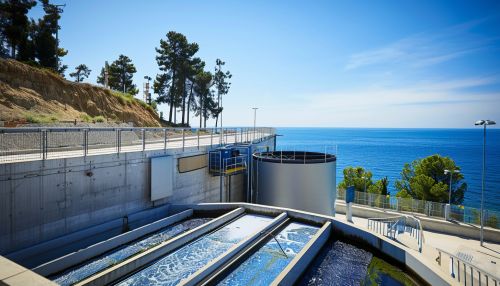Water desalination
Introduction
Water desalination is the process of removing salts and other minerals from saline water to produce water suitable for human consumption or irrigation. This process is critical in areas with limited access to fresh water, such as arid regions and islands. The technology has been used for centuries, but modern advancements have made it more efficient and environmentally friendly.


History
The concept of water desalination dates back to ancient times. The Greek philosopher Aristotle first described the process of heating salt water and collecting the fresh water vapor in his work "Meteorologica". This rudimentary method of desalination, known as distillation, was used by sailors and explorers during long sea voyages when fresh water supplies were depleted.
Process
There are several methods of water desalination, including distillation, reverse osmosis, and electrodialysis. The choice of method depends on factors such as the salinity of the water, energy costs, and environmental impact.
Distillation
Distillation involves heating saline water to create steam, which is then condensed to produce fresh water. This process effectively removes salts and other impurities, but it requires a significant amount of energy, making it less suitable for large-scale operations.
Reverse Osmosis
Reverse osmosis is the most common method of water desalination. It involves forcing saline water through a semi-permeable membrane under pressure. The membrane allows water molecules to pass through while blocking salts and other impurities. This method is more energy-efficient than distillation and is capable of handling large volumes of water.
Electrodialysis
Electrodialysis uses electrically charged membranes to separate salts from water. This method is effective for desalinating brackish water with lower salt concentrations. However, it is less effective for seawater, which has a higher salt concentration.
Environmental Impact
While water desalination provides a critical source of fresh water in many regions, it also has environmental implications. The process requires significant energy, contributing to greenhouse gas emissions. Additionally, the brine byproduct of desalination, which contains concentrated salts and other chemicals, must be carefully managed to prevent harm to marine ecosystems.
Future Developments
Research is ongoing to improve the efficiency and reduce the environmental impact of water desalination. Emerging technologies include forward osmosis, which uses a natural osmotic gradient to draw water across a membrane, and solar desalination, which harnesses solar energy to heat and evaporate water.
